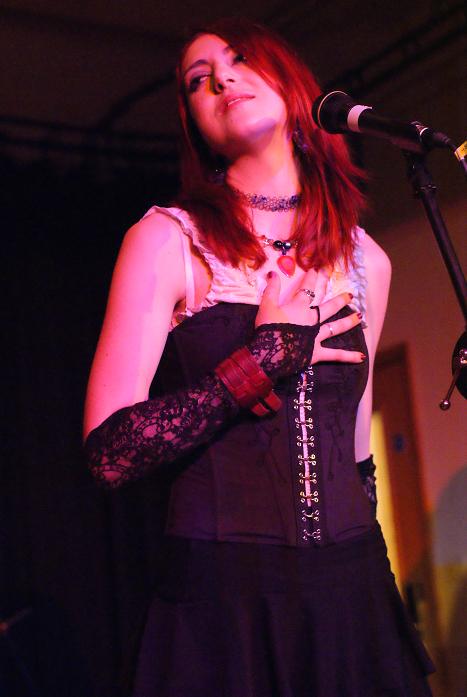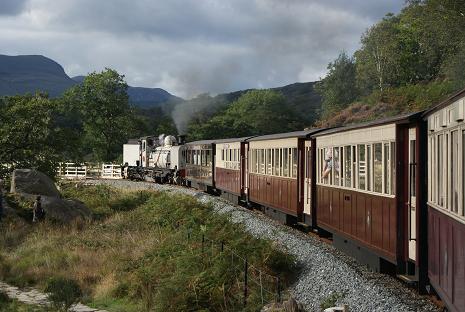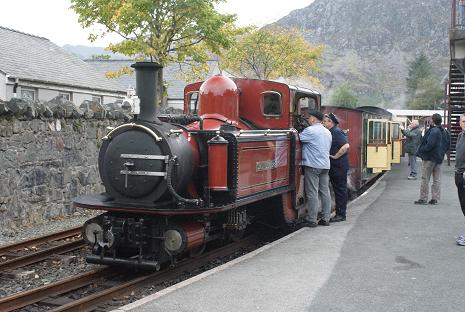Over the past couple of weeks I’ve been to quite a few gigs, and have been most remiss in reviewing them. This post is an attempt to rectify that.

Kim Serviour of Touchstone
First up was Touchstone, promoted by the Classic Rock Society in The Wesley Centre in Maltby, just outside Rotherham, the latest of my “lets stay in a cheap B&B to see a great prog band play a small town in the middle of nowhere”,weekends. The venue is a quite small but modern hall; standing at the front, tiered seating at the back, with a capacity of I guess about 150 people. Wasn’t full, but the CRS are better at pulling in the punters than one or two other ‘promoters’, so there was a decent crowd.
Support was six-piece Dee Expus, who I’m managed to miss on one of the smaller stages at the Cambridge Rock Festival, but who played a great set of modern-sounding streamlined guitar prog. Hats off to their bassist for doing the gig despite suffering from a hernia (did he try to lift a Mellotron?).
A couple of months before they’d rocked the Cambridge Rock Festival main stage, and tonight Touchstone gave another demonstration of just how much they’ve improved since I first saw them support The Reasoning two years ago. Kim Seviour has matured from a shy girl who was little more than a backing singer to a self-confident frontwoman who dominates the stage. Their blend of melodic hard rock and prog manages just the right combination of tightness and energy level; their instrumental virtuosity sufficiently restrained that solos never outstay they welcome. With a headline-length set they played almost all of Wintercoast plus a few highlights from their debut, lovely to hear songs like Kim’s very moving ‘Solace’ played live. They ended with a prog-disco version of Michael Jackson’s “Thriller”. On the evidence of this, they’re well on the road to world domination; in a year’s time I’m sure they’ll be playing far bigger venues than this one.
After all this prog, The Bad Shepherds on Wednesday night at the newly-reopened Band On The Wall are a bit of a change of pace. I’d had tickets for a couple of dates on their tour this time last year, with Mostly Autumn supporting. But that all went pear-shaped when the promoter ran off with more than just the money days before the start of the tour, leaving those who’s purchased tickets with no refunds.
The Band On The Wall is another new venue for me, since I’d never been before it closed for refurbishment a couple of years ago. Even though everything is new and shiny it’s got a character that featureless boxes like Manchester Academy can never hope to emulate.
The Bad Shepherds play celtic folk arrangements of 70s punk and new wave songs. They’re made up from former Young One Ade Edmundson on lead vocals and “Thrash Mandolin”, Troy Donockley on Uilleann pipes and various other celtic instruments with funny names, and Andy Dinan on fiddle. The original limeup also had Fairport Convention’s Maartin Allcock on bass, but too many other commitments forced him to drop out, to be replaced on this tour by Brad Lang.
After a short but sweet set from Ade Edmondson’s daughter Ella, The Bad Shepherds hit the stage with “I Fought the Law, and the Law Won”. Much of the set came from their album Yan, Tyan, Tethera, Methera!; their covers of standards by the likes of The Clash, The Jam and The Stanglers were often unrecognisable until the vocals started, and sound quite different with added fiddle solos. Highlight was probably Kraftwerk’s “The Model” played on Uilleann pipes. A hugely entertaining live band, even if you don’t particularly like the original songs.
Three days later it’s over to The Met Theater in Bury to see neo-prog veterans IQ.
IQ play old-fashioned prog. It’s all swirling keyboards, liquid guitar solos and strange time signatures you can’t dance to, and they may wear some influences on their sleeves, particularly Peter Gabriel era Genesis. But their distinct approach to melody and composition sets then well apart from just about any of their competitors.
It’s almost three years since I last saw IQ live, and I’d forgotten just how good they are. They’re both intense and impeccably tight, the complexities of the albums reproduced perfectly, the virtuosity of the band providing the perfect foil to Peter Nicholls’ theatrical delivery as frontman. It typical prog fashion, they started by playing the latest album, “Frequency” in it’s entirety, followed by just four older songs taking up the second half of the set, ending with the 20-minute epic “Narrow Margin” from their 1997 album “Subterranea“. Two encores, ending with a superb rendition of “The Wake” took the show to two and a half hours, playing (I think) exactly one song from every album featuring Peter Nicholls.
IQ don’t gig very often, but when they do, they’re well worth seeing.
The following Wednesday saw me return to The Band on the Wall for yet more prog, this time from legends The Enid, a band I hadn’t seen since The Reading Festival in 1982(!). They’ve gone through many, many lineup changes over the years, but the central figure has always been the charismatic Robert John Godfrey.
With so many years since I last saw them live, I had no real idea of what to expect, but The Enid proved they can still very much cut it live. Ably supported by a band including a bass player doubling up on Timpani, Robert John Godfrey entertained us with an hour and a half of what can best be described as classical music played on rock instrumentation, interspersed with a lot of banter between songs. Not owning much of their back catalogue I couldn’t name many of the pieces they played, although I did recognise “In the Region of the Summer Stars” quite early on. Sadly they no longer play things like “The Dambusters March” or “Land of Hope and Glory”; as Robert John Godfrey say, he doesn’t want to be mistaken for a Tory nowadays. While most their largely instrumental orchestral pomp isn’t really rock and roll, the powerful groove of last number of the main set rocked an absolute bastard. Naturally they got called back for several encores, RJG responding to someone’s shout of “Play some Chopin” by playing some Chopin, and they ended with “Something Wicked The Way Comes”.
With Progressive Nation 2009 two days later, that makes five gigs in thirteen days.



